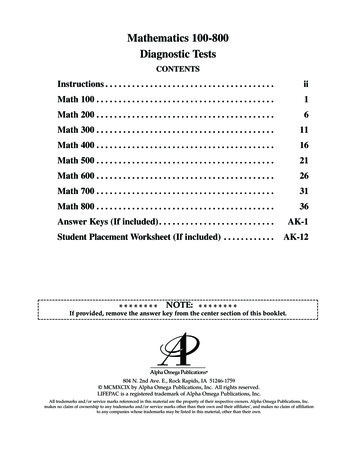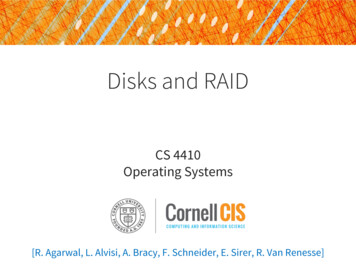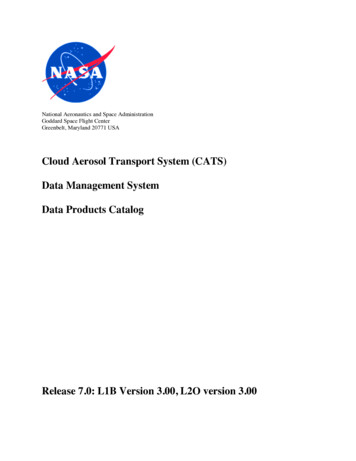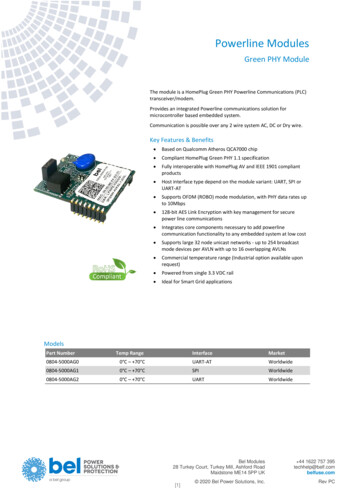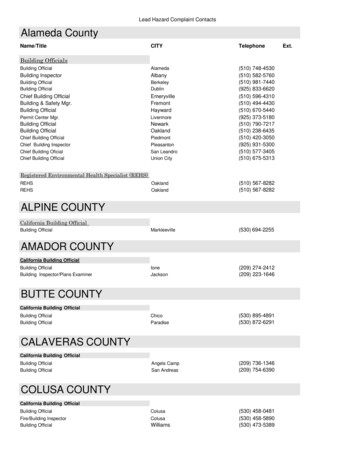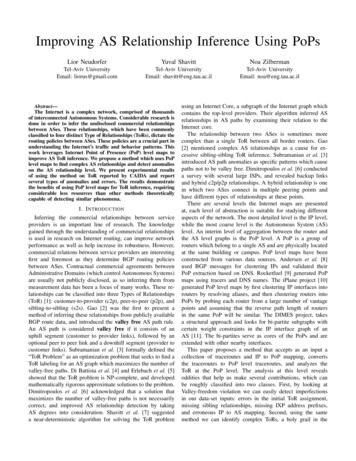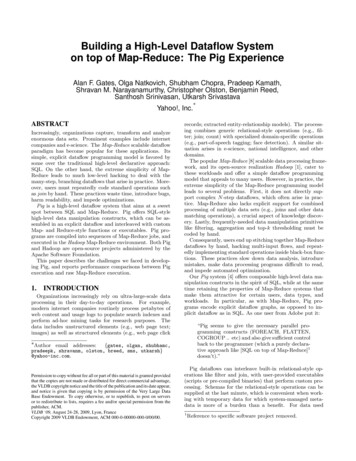
Transcription
Building a High-Level Dataflow Systemon top of Map-Reduce: The Pig ExperienceAlan F. Gates, Olga Natkovich, Shubham Chopra, Pradeep Kamath,Shravan M. Narayanamurthy, Christopher Olston, Benjamin Reed,Santhosh Srinivasan, Utkarsh Srivastava Yahoo!, Inc.ABSTRACTIncreasingly, organizations capture, transform and analyzeenormous data sets. Prominent examples include internetcompanies and e-science. The Map-Reduce scalable dataflowparadigm has become popular for these applications. Itssimple, explicit dataflow programming model is favored bysome over the traditional high-level declarative approach:SQL. On the other hand, the extreme simplicity of MapReduce leads to much low-level hacking to deal with themany-step, branching dataflows that arise in practice. Moreover, users must repeatedly code standard operations suchas join by hand. These practices waste time, introduce bugs,harm readability, and impede optimizations.Pig is a high-level dataflow system that aims at a sweetspot between SQL and Map-Reduce. Pig offers SQL-stylehigh-level data manipulation constructs, which can be assembled in an explicit dataflow and interleaved with customMap- and Reduce-style functions or executables. Pig programs are compiled into sequences of Map-Reduce jobs, andexecuted in the Hadoop Map-Reduce environment. Both Pigand Hadoop are open-source projects administered by theApache Software Foundation.This paper describes the challenges we faced in developing Pig, and reports performance comparisons between Pigexecution and raw Map-Reduce execution.1.INTRODUCTIONOrganizations increasingly rely on ultra-large-scale dataprocessing in their day-to-day operations. For example,modern internet companies routinely process petabytes ofweb content and usage logs to populate search indexes andperform ad-hoc mining tasks for research purposes. Thedata includes unstructured elements (e.g., web page text;images) as well as structured elements (e.g., web page clickrecords; extracted entity-relationship models). The processing combines generic relational-style operations (e.g., filter; join; count) with specialized domain-specific operations(e.g., part-of-speech tagging; face detection). A similar situation arises in e-science, national intelligence, and otherdomains.The popular Map-Reduce [8] scalable data processing framework, and its open-source realization Hadoop [1], cater tothese workloads and offer a simple dataflow programmingmodel that appeals to many users. However, in practice, theextreme simplicity of the Map-Reduce programming modelleads to several problems. First, it does not directly support complex N -step dataflows, which often arise in practice. Map-Reduce also lacks explicit support for combinedprocessing of multiple data sets (e.g., joins and other datamatching operations), a crucial aspect of knowledge discovery. Lastly, frequently-needed data manipulation primitiveslike filtering, aggregation and top-k thresholding must becoded by hand.Consequently, users end up stitching together Map-Reducedataflows by hand, hacking multi-input flows, and repeatedly implementing standard operations inside black-box functions. These practices slow down data analysis, introducemistakes, make data processing programs difficult to read,and impede automated optimization.Our Pig system [4] offers composable high-level data manipulation constructs in the spirit of SQL, while at the sametime retaining the properties of Map-Reduce systems thatmake them attractive for certain users, data types, andworkloads. In particular, as with Map-Reduce, Pig programs encode explicit dataflow graphs, as opposed to implicit dataflow as in SQL. As one user from Adobe put it:“Pig seems to give the necessary parallel programming constructs (FOREACH, FLATTEN,COGROUP . etc) and also give sufficient controlback to the programmer (which a purely declarative approach like [SQL on top of Map-Reduce]1doesn’t).” Author email addresses:{gates, olgan, shubhamc,pradeepk, shravanm, olston, breed, sms, utkarsh}@yahoo-inc.com.Permission to copy without fee all or part of this material is granted providedthat the copies are not made or distributed for direct commercial advantage,the VLDB copyright notice and the title of the publication and its date appear,and notice is given that copying is by permission of the Very Large DataBase Endowment. To copy otherwise, or to republish, to post on serversor to redistribute to lists, requires a fee and/or special permission from thepublisher, ACM.VLDB ‘09, August 24-28, 2009, Lyon, FranceCopyright 2009 VLDB Endowment, ACM 000-0-00000-000-0/00/00.Pig dataflows can interleave built-in relational-style operations like filter and join, with user-provided executables(scripts or pre-compiled binaries) that perform custom processing. Schemas for the relational-style operations can besupplied at the last minute, which is convenient when working with temporary data for which system-managed metadata is more of a burden than a benefit. For data used1Reference to specific software project removed.
exclusively in non-relational operations, schemas need notbe described at all.Pig compiles these dataflow programs, which are writtenin a language called Pig Latin [15], into sets of Hadoop MapReduce jobs, and coordinates their execution. By relyingon Hadoop for its underlying execution engine, Pig benefitsfrom its impressive scalability and fault-tolerance properties.On the other hand, Pig currently misses out on optimizedstorage structures like indexes and column groups. Thereare several ongoing efforts to add these features to Hadoop.Despite leaving room for improvement on many fronts, Pighas been widely adopted in Yahoo, with hundreds of usersand thousands of jobs executed daily, and is also gainingtraction externally with many successful use cases reported.This paper describes the challenges we faced in developingPig, including implementation obstacles as well as challengesin transferring the project from a research team to a development team and converting it to open-source. It also reports performance measurements comparing Pig executionand raw Hadoop execution.1.1Related WorkFor the most part, Pig is merely a combination of knowntechniques that fulfills a practical need. That need appearsto be widespread, as several other systems are emerging thatalso offer high-level languages for Map-Reduce-like environments: DryadLINQ [20], Hive [3], Jaql [5], Sawzall [16] andScope [6]. With the exception of Sawzall, which providesa constrained filter-aggregate abstraction on top of a singleMap-Reduce job, these systems appear to have been developed after or concurrently with Pig. Some of these systemsadopt SQL syntax (or a close variant), whereas others intentionally depart from SQL, presumably motivated by scenarios for which SQL was not deemed the best fit.1.2OutlineRather than trying to be comprehensive, this paper focuses on aspects of Pig that are somewhat non-standardcompared to conventional SQL database systems. After giving an overview of the system, we describe Pig’s type system (including nested types, type inference and lazy casting), generation, optimization and execution of query plansin the Map-Reduce context, and piping data through usersupplied executables (“streaming”). We then present performance numbers, comparing Pig execution against handcoded Map-Reduce execution. At the end of the paper, wedescribe some of our experiences building and deploying Pig,and mention some of the ways Pig is being used (both insideand outside of Yahoo).2.SYSTEM OVERVIEWThe Pig system takes a Pig Latin program as input, compiles it into one or more Map-Reduce jobs, and then executes those jobs on a given Hadoop cluster. We first givethe reader a flavor of Pig Latin through a quick example,and then describe the various steps that are carried out byPig to execute a given Pig Latin program.Example 1. Consider a data set urls: (url, category,pagerank). The following Pig Latin program finds, for eachsufficiently large category, the top ten urls in that categoryby pagerank.Figure 1: Pig compilation and execution stages.urls LOAD ‘dataset’ AS (url, category, pagerank);groups GROUP urls BY category;bigGroups FILTER groups BY COUNT(urls) 1000000;result FOREACH bigGroups GENERATEgroup, top10(urls);STORE result INTO ‘myOutput’;Some of the salient features of Pig Latin as demonstratedby the above example include (a) a step-by-step dataflowlanguage where computation steps are chained togetherthrough the use of variables, (b) the use of high-level transformations, e.g., GROUP, FILTER, (c) the ability to specifyschemas as part of issuing a program, and (d) the use of userdefined functions (e.g., top10) as first-class citizens. Moredetails about Pig Latin and the motivations for its designare given in [15].Pig allows three modes of user interaction:1. Interactive mode: In this mode, the user is presented with an interactive shell (called Grunt), whichaccepts Pig commands. Plan compilation and execution is triggered only when the user asks for output through the STORE command. (This practice enables Pig to plan over large blocks of program logic.There are no transactional consistency concerns, because Hadoop data is immutable.)2. Batch mode: In this mode, a user submits a prewritten script containing a series of Pig commands,typically ending with STORE. The semantics are identical to interactive mode.3. Embedded mode: Pig is also provided as a Java library allowing Pig Latin commands to be submittedvia method invocations from a Java program. Thisoption permits dynamic construction of Pig Latin programs, as well as dynamic control flow, e.g. looping fora non-predetermined number of iterations, which is notcurrently supported in Pig Latin directly.In interactive mode, two commands are available to helpthe user reason about the program she is using or creating:DESCRIBE and ILLUSTRATE. The DESCRIBE command displaysthe schema of a variable (e.g. DESCRIBE urls, DESCRIBEbigGroups). The ILLUSTRATE command displays a smallamount of example data for a variable and the variables in
its derivation tree, to give a more concrete illustration ofthe program semantics; the technology behind Pig’s example data generator is described in [14]. These features areespecially important in the Pig context, given the complexity of dealing with nested data, partially-specified schemas,and inferred types (see Section 3).Regardless of the mode of execution used, a Pig programgoes through a series of transformation steps before beingexecuted, depicted in Figure 1.The first step is parsing. The parser verifies that the program is syntactically correct and that all referenced variables are defined. The parser also performs type checkingand schema inference (see Section 3). Other checks, suchas verifying the ability to instantiate classes corresponding to user-defined functions and confirming the existenceof streaming executables referenced by the user’s program,also occur in this phase. The output of the parser is a canonical logical plan with a one-to-one correspondence betweenPig Latin statements and logical operators, arranged in adirected acyclic graph (DAG).The logical plan generated by the parser is passed througha logical optimizer. In this stage, logical optimizations suchas projection pushdown are carried out. The optimizedlogical plan is then compiled into a series of Map-Reducejobs (see Section 4), which then pass through another optimization phase. An example of Map-Reduce-level optimization is utilizing the Map-Reduce combiner stage to performearly partial aggregation, in the case of distributive or algebraic [12] aggregation functions.The DAG of optimized Map-Reduce jobs is then topologically sorted, and jobs are submitted to Hadoop for executionin that order (opportunities for concurrent execution of independent branches are not currently exploited). Pig monitors the Hadoop execution status, and periodically reportsthe progress of the overall Pig program to the user. Anywarnings or errors that arise during execution are loggedand reported to the user.3.TYPE SYSTEM AND TYPE INFERENCEPig has a nested data model, thus supporting complex,non-normalized data. Standard scalar types of int, long,double, and chararray (string) are supported. Pig alsosupports a bytearray type that represents a collection ofuninterpreted bytes. The type bytearray is also used tofacilitate unknown data types and lazy conversion of types,as described in Sections 3.1 and 3.2.Pig supports three complex types: map, tuple, and bag.map is an associative array, where the key is a chararray andthe value is of any type. We chose to include this type in Pigbecause much of Yahoo’s data is stored in this way due tosparsity (many tuples only contain a subset of the possibleattributes). tuple is an ordered list of data elements. Theelements of tuple can be of any type, thus allowing nestingof complex types. bag is a collection of tuples.When Pig loads data from a file (and conversely when itstores data into a file), it relies on storage functions to delimit data values and tuples. The default storage functionuses ASCII character encoding. It uses tabs to delimit datavalues and carriage returns to delimit tuples, and left/rightdelimiters like { } to encode nested complex types. Pig alsocomes with a binary storage function called BinStorage. Inaddition, users are free to define their own storage function,e.g., to operate over files emitted by another system, to cre-ate data for consumption by another system, or to performspecialized compression. To use a storage function otherthan the default one, the user gives the name of the desiredstorage function in the LOAD or STORE command.3.1Type DeclarationData stored in Hadoop may or may not have schema information stored with it. For this reason, Pig supports threeoptions for declaring the data types of fields. The first option is that no data types are declared. In this case thedefault is to treat all fields as bytearray. For example:a LOAD ‘data’ USING BinStorage AS (user);b ORDER a BY user;The sorting will be done by byte radix order in this case. Using bytearray as the default type avoids unnecessary castingof data that may be expensive or corrupt the data.Note that even when types are undeclared, Pig may beable to infer certain type information from the program. Ifthe program uses an operator that expects a certain typeon a field, then Pig will coerce that field to be of that type.In the following example, even though addr is not declaredto be a map, Pig will coerce it to be one since the programapplies the map dereference operator # to it:a LOAD ‘data’ USING BinStorage AS (addr);b FOREACH a GENERATE addr#‘state’;Another case where Pig is able to know the type of a fieldeven when the program has not declared types is when operators or user-defined functions (UDFs) have been appliedwhose return type is known. In the following example, Pigwill order the output data numerically since it knows thatthe return type of COUNT is long:abcd LOAD ‘data’ USING BinStorage AS (user);GROUP a BY user;FOREACH b GENERATE COUNT(a) AS cnt;ORDER c BY cnt;The second option for declaring types in Pig is to providethem explicitly as part of the AS clause during the LOAD:a LOAD ‘data’ USING BinStorageAS (user:chararray);b ORDER a BY user;Pig now treats user as a chararray, and the ordering willbe done lexicographically rather than in byte order.The third option for declaring types is for the load function itself to provide the schema information, which accommodates self-describing data formats such as JSON. We arealso developing a system catalog that maintains schema information (as well as physical attributes) of non-selfdescribing data sets stored in a Hadoop file system instance.It is generally preferable to record schemas (via either selfdescription or a catalog) for data sets that persist over timeor are accessed by many users. The option to forgo storedschemas and instead specify (partial) schema informationthrough program logic (either explicitly with AS, or implicitly via inference) lowers the overhead for dealing with transient data sets, such as data imported from a foreign sourcefor one-time processing in Hadoop, or a user’s “scratch” datafiles.
Figure 2: Pig Latin to logical plan translation.3.2Lazy Conversion of TypesWhen Pig does need to cast a bytearray to another typebecause the program applies a type-specific operator, it delays that cast to the point where it is actually necessary.Consider this example:students LOAD ‘data’ USING BinStorageAS (name, status, possiblePoints, earnedPoints);paid FILTER students BY status ‘paid’;gpa FOREACH paid GENERATE name,earnedPoints / possiblePoints;In this example, status will need to be cast to a chararray(since it is compared to constant of type chararray), andearnedPoints and possiblePoints will need to be cast todouble since they are operands of the division operator.However, these casts will not be done when the data isloaded. Instead, they will be done as part of the comparisonand division operations, which avoids casting values that areremoved by the filter before the result of the cast is used.4.COMPILATION TO MAP-REDUCEThis section describes the process of translating a logicalquery plan into a Map-Reduce execution plan. We describeeach type of plan, and then explain how Pig translates between them and optimizes the Map-Reduce plan.4.1Logical Plan StructureRecall from Section 2 that a Pig Latin program is translated in a one-to-one fashion to a logical plan. Figure 2shows an example. Each operator is annotated with theschema of its output data, with braces indicating a bag oftuples.2 With the exception of nested plans (Section 5.1.1)and streaming (Section 6), a Pig logical query plan resembles relational algebra with user-defined functions and aggregates.Pig currently performs a limited suite of logical optimizations to transform the logical plan, before the compilationinto a Map-Reduce plan. We are currently enriching theset of optimizations performed, to include standard System2Note that the keyword “group” is used both as a command (as in “GROUP D BY .”) and as the automaticallyassigned field name of the group key in the output of a groupby expression (as in “FOREACH E GENERATE group, .”).Figure 3: Map-Reduce execution stages.R-style heuristics like filter pushdown, among others. Joinordering does not appear to be an important issue in thePig/Hadoop context, because data is generally kept in nonnormalized form (after all, it is read-only); in practice Pigprograms seldom perform more than one join. On the otherhand, due to the prevalence of “wide” data tables, we doexpect to encounter optimization opportunities of the formstudied in the column-store context (e.g. deferred stitching),once column-wise storage structures are added to Hadoop.4.2Map-Reduce Execution ModelA Hadoop Map-Reduce job consists of a series of executionstages, shown in Figure 3. The map stage processes theraw input data, one data item at a time, and produces astream of data items annotated with keys. A subsequentlocal sort stage orders the data produced by each machine’smap stage by key. The locally-ordered data is then passedto an (optional) combiner stage for partial aggregation bykey.The shuffle stage then redistributes data among machinesto achieve a global organization of data by key (e.g. globallyhashed or ordered). All data received at a particular machine is combined into a single ordered stream in the mergestage. If the number of incoming streams is large (relativeto a configured threshold), a multi-pass merge operation isemployed; if applicable, the combiner is invoked after eachintermediate merge step. Lastly, a reduce stage processesthe data associated with each key in turn, often performingsome sort of aggregation.4.3Logical-to-Map-Reduce CompilationPig first translates a logical plan into a physical plan, andthen embeds each physical operator inside a Map-Reducestage to arrive at a Map-Reduce plan.33Pig can also target platforms other than Map-Reduce. Forexample, Pig supports a “local” execution mode in whichphysical plans are executed in a single JVM on one machine(the final physical-to-Map-Reduce phase is not performed inthis case). A student at UMass Amherst extended Pig toexecute in the Galago [19] parallel data processing environment.
Figure 5: Physical plan to map reduce plan translation.Figure 4: Logical plan to physical plan translation.Figure 4 shows our example logical plan translated to aphysical plan. For clarity each logical operator is shown withan id. Physical operators that are produced by the translation of a logical operator are shown with the same id. Forthe most part, each logical operator becomes a corresponding physical operator.The logical (CO)GROUP operator becomes a series of threephysical operators: local rearrange, global rearrange, andpackage. Rearrange is a term that stands for either hashingor sorting by key. The combination of local and global rearrange results in the data being arranged such that all tupleshaving the same group-by key wind up on the same machineand adjacent in the data stream. In the case of cogroupingmultiple incoming streams, the local rearrange operator firstannotates each tuple in a way that indicates its stream oforigin. The package operator places adjacent same-key tuples into a single-tuple “package,” which consists of the keyfollowed by one bag of tuples per stream of origin.The JOIN operator is handled in one of two ways: (1)rewrite into COGROUP followed by a FOREACH operator to perform “flattening” (see [15]), as shown in Figure 4, whichyields a parallel hash-join or sort-merge join, or (2) fragmentreplicate join [10], which executes entirely in the map stageor entirely in the reduce stage (depending on the surrounding operations). The choice of join strategy is controlledvia syntax (a future version of Pig may offer the option toautomate this choice).Having constructed a physical plan, Pig assigns physicaloperators to Hadoop stages (Section 4.2), with the goal ofminimizing the number of reduce stages employed. Figure 5shows the assignment of physical operators to Hadoop stagesfor our running example (only the map and reduce stages areshown). In the Map-Reduce plan, the local rearrange operator simply annotates tuples with keys and stream identifiers,and lets the Hadoop local sort stage do the work. Globalrearrange operators are removed because their logic is implemented by the Hadoop shuffle and merge stages. Loadand store operators are also removed, because the Hadoopframework takes care of reading and writing data.4.3.1Branching PlansIf a Pig Latin program contains more than one STORE command, the generated physical plan contains a SPLIT physicaloperator. The following program contains a logical SPLITcommand and ends with two STORE commands, one for eachbranch of the split:clicks LOAD ‘clicks’AS (userid, pageid, linkid, viewedat);SPLIT clicks INTOpages IF pageid IS NOT NULL,links IF linkid IS NOT NULL;cpages FOREACH pages GENERATE userid,CanonicalizePage(pageid) AS cpage,viewedat;clinks FOREACH links GENERATE userid,CanonicalizeLink(linkid) AS clink,viewedat;STORE cpages INTO ‘pages’;STORE clinks INTO ‘links’;The Map-Reduce plan for this program is shown in Figure 6(in this case, we have a “Map-only” plan, in which the Reduce step is disabled). Pig physical plans may contain nestedsub-plans, as this example illustrates. Here, the split operator feeds a copy of its input to two nested sub-plans, one foreach branch of the logical split operation. (The reason forusing a nested operator model for split has to do with flowcontrol during execution, as discussed later in Section 5.1.)
Figure 6: Split operator with nested sub-plans.The situation becomes tricker if the split propagates acrossa map/reduce boundary, which occurs in the following example:clicks LOAD ‘clicks’AS (userid, pageid, linkid, viewedat);goodclicks FILTER clicks BYviewedat IS NOT NULL;bypage GROUP goodclicks BY pageid;cntbypage FOREACH bypage GENERATE group,COUNT(goodclicks);STORE cntbypage INTO ‘bypage’;bylink GROUP goodclicks BY linkid;cntbylink FOREACH bylink GENERATE group,COUNT(goodclicks);STORE cntbylink INTO ‘bylink’;Here there is no logical SPLIT operator, but the Pig compilerinserts a physical SPLIT operator to duplicate thegoodclicks data flow. The Map-Reduce plan is shown inFigure 7. Here, the SPLIT operator tags each output tuple with the sub-plan to which it belongs. The MULTIPLEXoperator in the Reduce stage routes tuples to the correctsub-plan, which resume where they left off.The SPLIT/MULTIPLEX physical operator pair is a recentaddition to Pig motivated by the fact that users often wishto process a data set in multiple ways, but do not want topay the cost of reading it multiple times. Of course, thisfeature has a downside: Adding concurrent data processingpipelines reduces the amount of memory available for eachpipeline. For memory-intensive computations, this approachmay lead to spilling of data to disk (Section 5.2), which canoutweigh the savings from reading the input data only once.Also, pipeline multiplexing reduces the effectiveness of thecombiner (discussed next, in Section 4.4), since each run ofthe combiner only operates on as much data as it can fit intomemory. By multiplexing pipelines, a smaller portion of agiven pipeline’s data is held in memory, and thus less datareduction is achieved from each run of the combiner.Pig does not currently have an optimizer sophisticatedenough to reason about this tradeoff. Thus, Pig leaves thedecision to the user. The unit of compilation and executionis a Pig program submitted by the user, and Pig assumesthat if the program contains multiple STORE commands theyshould be multiplexed. If the user does not wish them to beFigure 7: Split and multiplex operators.multiplexed, she can submit the pipelines independently asseparate Pig programs.4.4Map-Reduce Optimization andJob GenerationOnce a Map-Reduce plan has been generated, there maybe room for additional optimizations. Currently only oneoptimization is performed at this level: Pig breaks distributive and algebraic [12] aggregation functions (such asAVERAGE) into a series of three steps: initial (e.g. generate (sum, count) pairs), intermediate (e.g. combine n (sum,count) pairs into a single pair), final (e.g. combine n (sum,count) pairs and take the quotient).4 These steps are assigned to the map, combine, and reduce stages respectively.5We have found that using the combiner as aggressivelyas possible has two benefits. The first is obvious: it typically reduces the volume of data handled by the shuffle andmerge phases, which often consume a significant portion ofjob execution time. Second, combining tends to equalize theamount of data associated with each key, which lessens skewin the reduce phase.The final compilation step is to convert each Map-Reducecombination (or just Map, if there is no final Reduce) into4The separation of initial from intermediate is necessary because recent versions of Hadoop do not guarantee that everytuple will pass through the combiner (these semantics leadto greater flexibility in the Hadoop layer, e.g. bypassing thecombiner in cases of a single data item for a given key).5Although we could have included this optimization as partof the main plan generation process (i.e. create separatephysical operators for the three aggregation steps), we optedto implement it as a separate transformation to make it moremodular and hence easier to interleave with other (future)optimizations, and also easy to disable for testing and microbenchmarking purposes.
a Hadoop job description that can be passed to Hadoop forexecution. This step involves generating a Java jar file thatcontains the Map and Reduce implementation classes, aswell as any user-defined functions that will be invoked aspart of the job. Currently, the Map and Reduce classes contain general-purpose dataflow execution engines (describednext in Section 5), which are configured at runtime to implement the designated plan. In the future we plan to considercode generation (see Section 10).5.PLAN EXECUTIONThis section describes the way Pig executes the portionof a physical plan that lies inside a Map or Reduce stage.5.1Flow ControlTo control movement of tuples through the executionpipeline, we considered both a push model and a pull (iterator) model [11]. We were attracted to the iterator model,which has a simple single-threaded6 implementation thatavoids context-switching overhead. Another advantage ofthe iterator model is that it leads to simple APIs for userdefined functions, which are especially important in thePig/Hadoop context because of the prevalence of customprocessing needs. A push model especially complicates theAPI (and implementation) of a UDF with multiple inputs.For the same reason, implementing binary operators likefragment-replicate join can be more difficult in the pushcase.On the other hand, two drawbacks of the iterator modelcaused some concern. One drawback in the Pig context isthat for operations over a bag nested inside a tuple (e.g.duplicate elimination on a nested bag, aggregation following group-by), the entire bag must be constituted beforebeing passed to the operation. If the bag overflows memory, the cost of spilling to disk must be paid. In practicemost operations over bags can make use of the combiner,such that memory overflows are handled by combining tuples rather than spilling the raw data to disk. Indeed, ifan operation is not amenable to a combiner (e.g. a holistic UDF) then materializing the entire bag is generally anintrinsic requirement; a push-based implementation wouldlead to the operation performing its own bag materialization internally. It is preferable for spilling to be managed aspart of the built-in infrastructure, for obvious reasons.Another potential
in a language called Pig Latin [15], into sets of Hadoop Map-Reduce jobs, and coordinates their execution. By relying on Hadoop for its underlying execution engine, Pig bene ts from its impressive scalability and fault-tolerance properties. On the other hand, Pig currently misses out on optimized storage structures like indexes and column .

